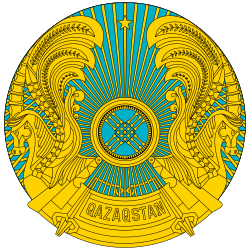Constitutional basis
The legal framework for presidential succession is contained in:
- Constitution of the Republic of Kazakhstan (1995), Article 48.
- Related laws regulating the status of Parliament and the Government.
Article 48, Paragraph 1 states: [1]
In case of early termination of the President's powers, his death, resignation, incapacity or removal from office, the powers of the President of the Republic shall be transferred to the Chairman of the Senate of the Parliament. In the case of the inability of the Chairman of the Senate to assume these powers, they shall be transferred to the Chairman of the Majilis of the Parliament. In the case of the inability of the latter, the powers shall be transferred to the Prime Minister of the Republic of Kazakhstan.
History
The institution of presidential succession in Kazakhstan has undergone several stages of development since the establishment of the office in April 1990, when the Presidency of the Kazakh SSR was created. At that time, in accordance with the Chapter 12-1, Article 114-8 of the Constitution of the Kazakh SSR, the powers of the head of state in case of vacancy were to be transferred to the Vice President of Kazakhstan, and if that post was absent or unable, then to the Chairman of the Supreme Soviet of the Kazakh SSR. [2] This arrangement remained in force during the first period of statehood after independence, with the adoption of the 1993 Constitution of Kazakhstan largely preserving the same procedure, though it additionally required that snap presidential elections be conducted within two months, while the acting head of state temporarily exercised presidential authority. [3]
A more systematic approach appeared with the adoption of the 1995 Constitution of Kazakhstan, approved by national referendum on 30 August 1995 and entering into force on 5 September 1995 under Presidential Decree No. 2454, which for the first time set out in detail the order of succession. [4] It was defined that in the event of early termination of presidential powers, they would be assumed by the Chairman of the Senate of Parliament, and if that office was not available, then by the Chairman of the Mäjilis, followed by the Prime Minister of Kazakhstan. [5]
Beyond the constitutional provisions, Kazakhstan has maintained a formal protocol hierarchy of officials, which determines ceremonial precedence at state and international events. The ProtocolSeniority of Officials of the Republic of Kazakhstan during Domestic and International Events, issued by presidential decree in 2006, listed the relative ranking of key officials, including the First President, the head of the Presidential Administration, parliamentary leaders, and other senior government figures. [6] While this list does not affect constitutional succession, it provides insight into the practical political hierarchy and the prominence of various offices within the state apparatus. [7] In 2025, President Kassym-Jomart Tokayev issued amendments to the protocol, updating certain positions, reordering specific offices, and adjusting ceremonial precedence such as removing the First President and certain top offices. [8] [9]
This page is based on this
Wikipedia article Text is available under the
CC BY-SA 4.0 license; additional terms may apply.
Images, videos and audio are available under their respective licenses.
